The world is moving towards healthier living, and veggies are in high demand. Cabbage, part of the Brassicaceae family, is a standout. It offers many uses in cooking and processing. But are we using cabbage to its fullest potential? Let’s explore advanced cabbage processing and its exciting uses.
Key Takeaways
- Cabbage’s versatility extends beyond traditional uses, with emerging industrial applications and value-added products.
- Innovative processing techniques are unlocking new dimensions in cabbage utilisation, from shredding and sanitisation to fermentation and packaging.
- Cutting-edge technologies, such as automated sorting and grading systems, are enhancing efficiency and quality control in cabbage processing.
- Sustainable practices and waste reduction strategies are redefining the cabbage industry, paving the way for a more environmentally conscious future.
- Cabbage’s economic significance is set to grow, with expanding global markets and evolving consumer preferences driving innovation and investment.
What are the latest processing methods and applications that will change cabbage’s role? Find out in our article and discover cabbage’s true potential.
Evolution and History of Cabbage Cultivation
Cabbage is a versatile and nutritious vegetable with a long history. It comes from the wild Brassica oleracea, found in Western Europe and the Western Mediterranean. Over time, humans selected and adapted it, creating the many cabbage varieties we know today.
Origins in Mediterranean and Asia Minor
The first cabbage cultivation records are from ancient Greece and Rome. They valued it for its health benefits and taste. It spread slowly, reaching Germany by 1150 AD.
By the 14th century, cabbage had made its way to England. This marked another milestone in its global journey.
Development of Modern Varieties
Over the years, cabbage has changed a lot. Breeders and farmers have worked to create new, better varieties. Now, we have green, red, and savoy cabbages, each with its own taste and texture.
Global Spread and Adoption
Cabbage’s popularity grew as the world connected more. European explorers brought it to North America and India. Today, it’s a key ingredient in many cuisines worldwide.
The story of cabbage is one of resilience and versatility. From ancient times to today, it has won the hearts of many. It offers a wide range of flavors and uses in cooking.
Understanding Cabbage Varieties and Their Processing Potential
Cabbage is a key vegetable in many dishes, with a wide range of varieties. Each type has its own look and uses. From bright green to deep purple, cabbage’s beauty is just the start.
Cabbage is loved for its many uses in cooking. Techniques like shredding, fermenting, and drying open up new ways to enjoy it. You can make everything from fresh salads to tangy sauerkraut and hearty cabbage rolls.
Different cabbages come in various shapes, sizes, colours, and leaf types. Cabbages in the brassica family can handle cold temperatures, growing best between 15°C and 20°C. New seed treatments help them grow well in different conditions.
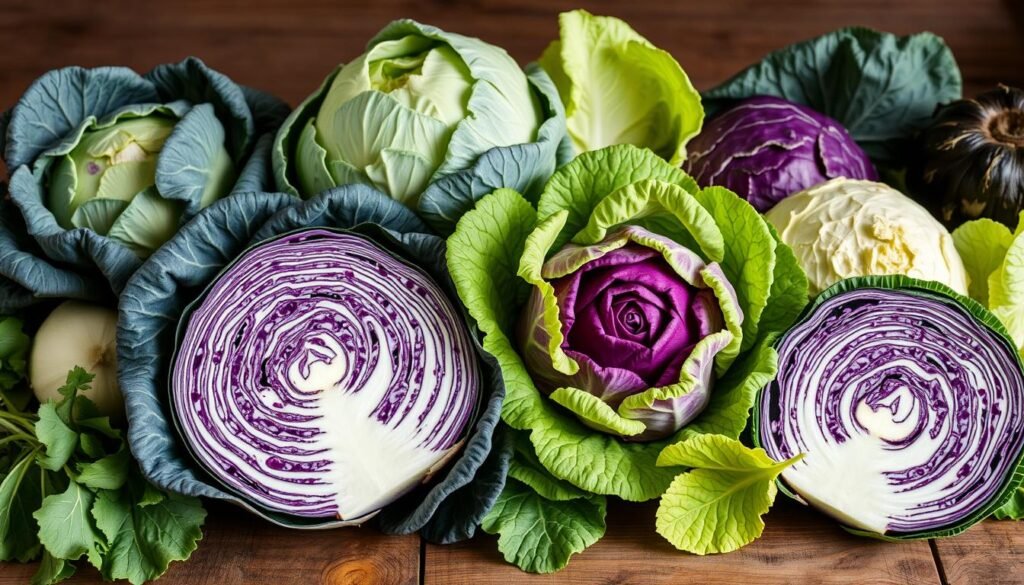
How cabbages are planted can change based on the market and growing method. Soil type and drainage are important. Growers also need to manage water, soil health, and diseases for the best results. Cabbage needs about 25mm of water every 7 to 10 days, especially when heads are forming.
Cabbage is versatile, whether for fresh sales or processing. The industry keeps finding new ways to use it. This opens up endless possibilities for cooking and creating new products.
Market Overview and Economic Significance
The global cabbage industry is lively and changing fast. It covers 2,414 thousand hectares and produces 70,862.50 thousand tonnes every year. India, the second-biggest producer after China, grows cabbage on 397 thousand hectares and makes 9,207 thousand tonnes.
This shows how much people want cabbage and how important it is in the cabbage market trends around the world.
Cabbage production shows the industry’s wide reach and big impact. Health awareness, green farming, and more trade are making the cabbage market grow. But, the Australian cabbage industry has its own problems. It deals with changing tastes and costs.
Global Production Statistics
The world grows cabbage very efficiently, with 29.3 tonnes per hectare. China’s big role as the top producer shows how key cabbage is in our food system.
Market Trends and Demand Analysis
The cabbage market is changing because people want healthier, greener food. As tastes shift, farmers and makers need to be quick to grab new chances.
Economic Impact in Australia
In Australia, cabbage is a big deal for farming. It faces issues like higher labor costs and competition. Yet, the Australian cabbage industry is still important. It creates jobs and helps keep our food safe.
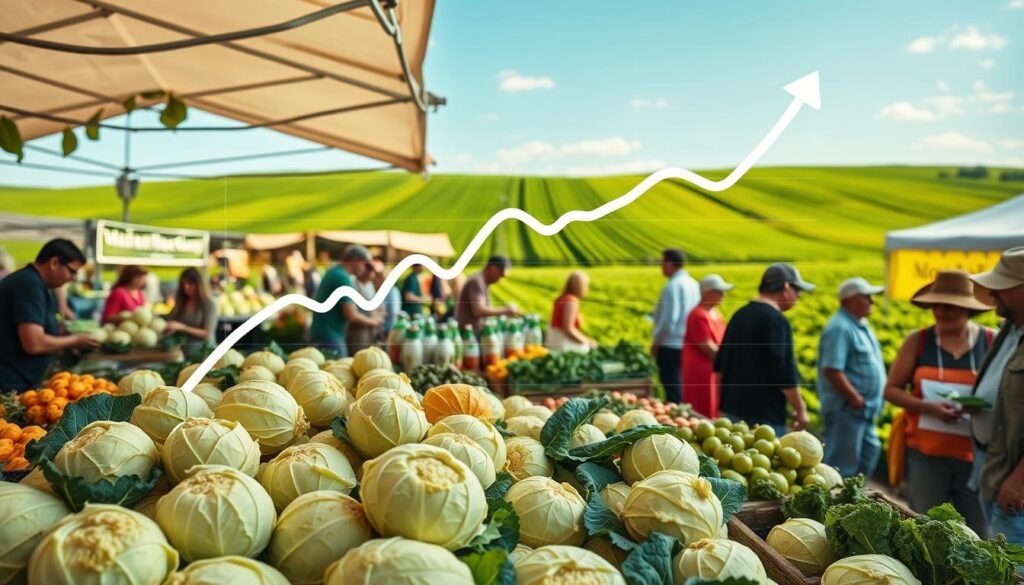
“The future of the cabbage industry lies in its ability to innovate, adapt, and meet the changing needs of consumers and the broader market.”
Cabbage processing,Industrial cabbage processing,Cabbage-based products
The world of cabbage processing has changed a lot. It now offers many new options for everyone involved. From simple steps like cleaning and cutting to complex industrial methods, the cabbage industry has grown a lot. Let’s look into how cabbage is processed today and the new equipment and products that are changing the market.
Cabbage Processing Techniques
Processing cabbage is a detailed process. It starts with cleaning, then cutting and shredding. High-tech equipment like big slicers and automated feeders help make the product consistent and efficient.
Industrial Cabbage Processing Equipment
The industrial side of cabbage processing has seen big improvements. Machines can now handle up to 3,500 kg/h. This means more cabbage products can be made quickly and efficiently. These machines include automated slicers, washing units, and packaging systems, all working together to improve quality and speed.
Cabbage-Based Food Products
Cabbage is used in many different foods now. From sauerkraut and kimchi to fresh salads and juice, the industry keeps finding new ways to use it. These products are popular with people who want healthy food, helping the market grow.
The future of cabbage processing looks bright. With new techniques and equipment, the industry is ready to offer even more high-quality cabbage products. These will surely appeal to food lovers around the world.
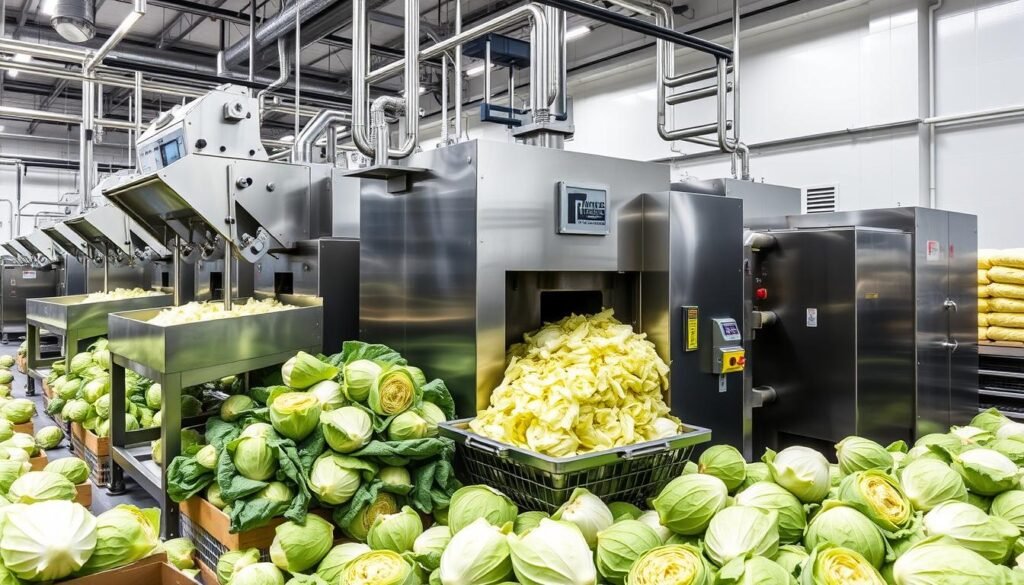
“Cabbage processing is no longer just about cutting and packaging – it’s about unlocking the full potential of this versatile vegetable to create innovative, nutritious, and delightful products.”
Advanced Processing Equipment and Technology
In the world of cabbage processing, modern plants are using new equipment and technologies. These advancements improve efficiency, ensure quality, and meet market demands. They are changing the industry, helping producers get the most out of this versatile vegetable.
Industrial Shredding Systems
Industrial shredding systems are key in cabbage processing. They cut cabbage heads into uniform pieces, ensuring consistent size and texture. These machines use advanced blades and control systems to reduce waste and increase yield.
Washing and Sanitisation Equipment
Keeping food clean is crucial in the industry. Cabbage processing plants use top-notch washing and sanitisation equipment. These systems clean the cabbage thoroughly, removing dirt and contaminants, making the product safe for further processing or packaging.
Automated Packaging Solutions
Efficiency and consistency are important in cabbage processing. Automated packaging solutions make the packing process smooth and efficient. These technologies, like high-speed bagging machines, improve productivity and reduce errors.
These advanced technologies have changed the cabbage processing world. By using the latest equipment, producers can work better, keep quality high, and stay competitive in a fast-changing market.
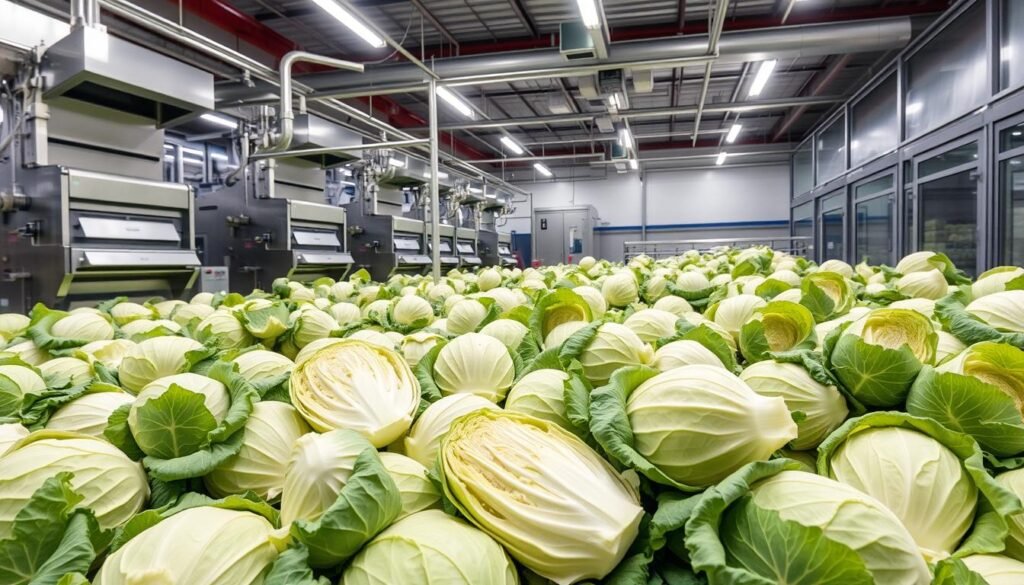
| Technology | Key Features | Benefits |
|---|---|---|
| Industrial Shredding Systems |
|
|
| Washing and Sanitisation Equipment |
|
|
| Automated Packaging Solutions |
|
|
Quality Control and Grading Systems
We focus a lot on quality control and grading in our cabbage processing. We check size, colour, texture, and look for any defects. This way, we make sure our cabbage products are top-notch and our customers are happy.
We use advanced tech to grade our cabbage automatically. This tech helps us sort and categorise our cabbage quickly and accurately. It also gives us useful info about our crop’s quality.
| Grade | Requirements | Tolerance for Defects |
|---|---|---|
| U.S. No. 1 | Reasonably solid heads, free from soft rot, seeds, and damage | Not more than 10% of heads in any lot may fail to meet the grade, with 2% allowable for soft decay |
| U.S. Commercial | Heads should meet U.S. No. 1 grade specifications but with increased tolerance for defects | Not more than 25% of heads in any lot may fail to meet the requirements, with 10% allowed for defects causing serious damage and 2% for soft decay |
We stick to strict cabbage processing standards to meet our customers’ high expectations. Our dedication to cabbage quality control and cabbage grading is key to our success. It helps us provide the best experience for our customers.
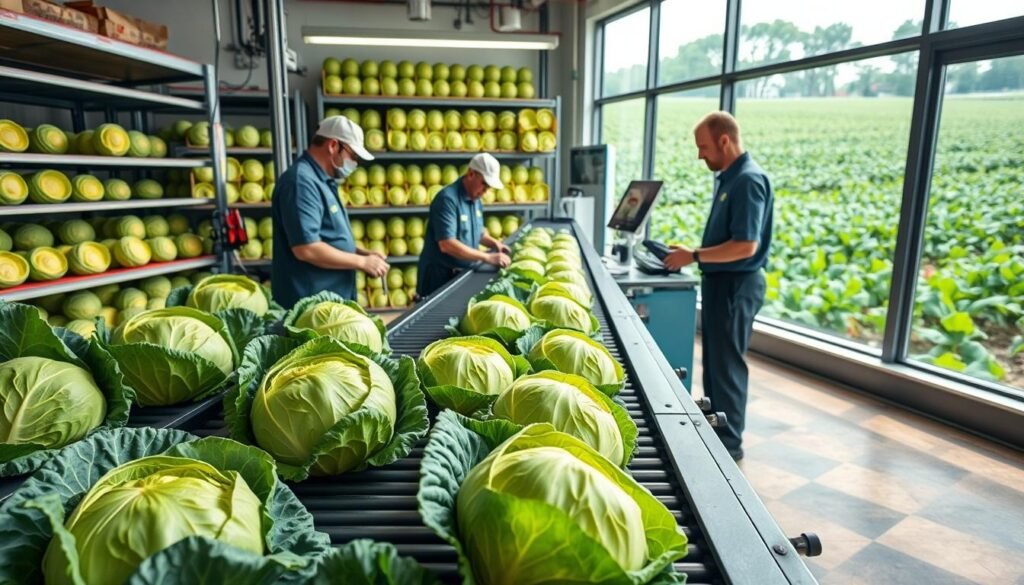
Fermentation Techniques and Applications
Cabbage fermentation is key in making sauerkraut and kimchi. It uses salt for natural fermentation or starter cultures for modern methods. These methods improve taste, texture, and nutrition of cabbage products. They also create new, probiotic-rich foods that consumers want.
Traditional Fermentation Methods
For ages, cabbage has been fermented naturally. This method uses lactic acid bacteria on the cabbage. Shredded cabbage is put in brine, fermenting for weeks.
The result is tangy sauerkraut or kimchi. These products have a crunchy texture and unique taste.
Modern Industrial Fermentation
Today, the cabbage industry uses advanced fermentation. It uses controlled environments and starter cultures. This makes the fermentation process better.
It allows for better control over pH, temperature, and bacteria. This leads to better taste, nutrition, and longer shelf life for fermented cabbage products.
Product Development Opportunities
New fermentation methods have opened up many product development chances. Manufacturers can now make a variety of fermented cabbage products. This includes probiotic-rich sauerkraut and kimchi-inspired foods.
The range of possibilities is huge. It promises to grow the cabbage industry even more.
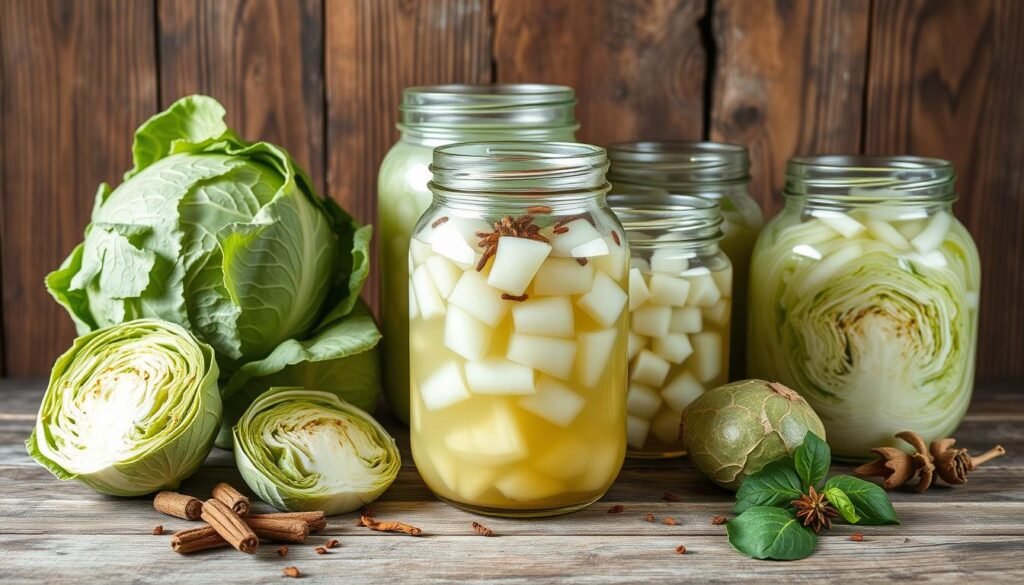
“Fermentation is a powerful tool that can unlock the true potential of cabbage, transforming it into a diverse range of flavourful and nutritious products.”
Innovative Product Development Strategies
In the fast-paced cabbage processing industry, innovation is crucial. It helps us reach more markets and meet changing consumer tastes. We’re always looking to introduce new, exciting products, from ready-to-eat salads to cabbage-based snacks and drinks.
We’re also working on convenience items like pre-cut cabbage and meal kits. These products save time but are still healthy. They make it easy for people to enjoy cabbage in their busy lives.
Exploring cabbage juice extraction is another exciting area. We’re creating unique, healthy drinks from this versatile veggie. These beverages offer a refreshing, nutritious choice for those looking for something different.
We keep a close eye on market trends and what people want. This helps us spot new chances and shape our product plans. Our dedication to innovation keeps our range diverse and appealing to many.
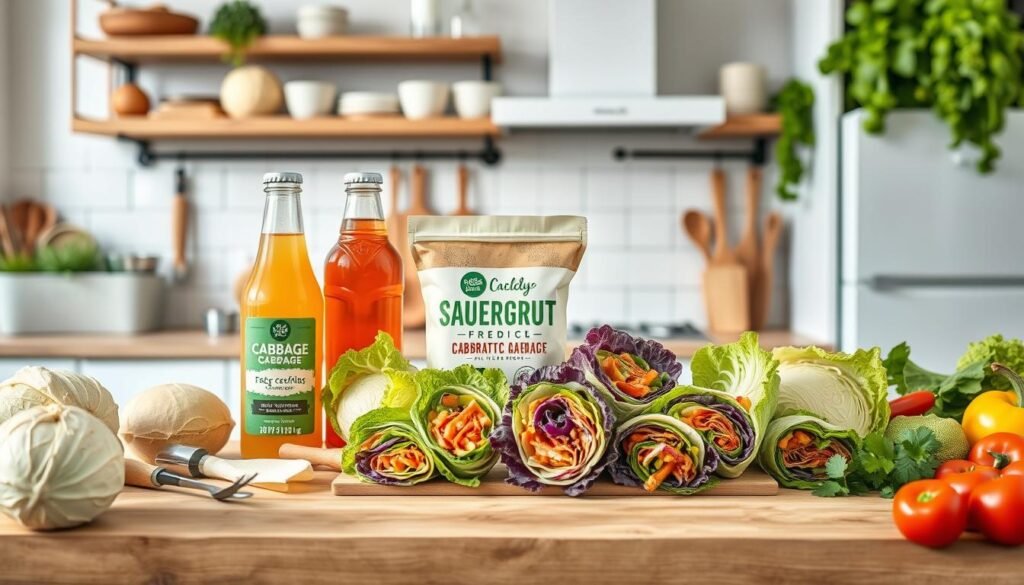
“Innovation is the key to unlocking the untapped potential of cabbage. By pushing the boundaries of product development, we can elevate this humble vegetable into a culinary powerhouse.”
As the cabbage industry grows, our innovative approach will keep driving success. By embracing cabbage’s versatility, we’re ready to offer a wide range of products. These will meet the changing needs of the market.
Packaging Solutions and Shelf Life Enhancement
Keeping cabbage products fresh and extending their shelf life is key in the processing industry. New packaging technologies are crucial for this. Modified atmosphere packaging (MAP) and vacuum packaging are top choices. They control the gases around the cabbage, slowing down spoilage.
Modern Packaging Technologies
MAP changes the oxygen and carbon dioxide levels in packaging. This creates a perfect environment for keeping cabbages fresh. It can make cabbages last up to 24 weeks longer, depending on the type.
Vacuum packaging removes air, reducing oxidation and microbial growth. This leads to a longer shelf life for the product.
Storage Optimisation Methods
Along with new packaging, managing storage conditions is vital. Temperature and humidity control is key. Cabbages breathe and produce ethylene differently at various temperatures.
Keeping them between 1°C and 10°C is best. This slows down their breathing and ethylene production, keeping them fresh longer.
Quality Preservation Techniques
The industry also uses quality preservation methods to extend cabbage shelf life. Natural preservatives like plant extracts and essential oils are effective. They stop microbes from growing and keep cabbages nutritious and tasty.
New packaging materials, like pH-sensitive films and chitosan-based coatings, also help. They keep cabbage products fresh for longer.
| Packaging Method | Shelf Life Extension | Key Benefits |
|---|---|---|
| Modified Atmosphere Packaging (MAP) | Up to 24 weeks | Slows down spoilage by regulating O2 and CO2 levels |
| Vacuum Packaging | Increased by 30-50% | Reduces oxidation and microbial growth |
| Natural Preservatives (Plant Extracts, Essential Oils) | Up to 8 days | Inhibits microbial growth, maintains quality |
| pH-sensitive and Chitosan-based Films | Increased by 30-40% | Enhances freshness and antimicrobial properties |
By using these advanced cabbage packaging, shelf life extension, and cabbage storage optimisation methods, the industry can provide high-quality, fresh, and long-lasting cabbage products to consumers.
Sustainable Processing Practices
We’re leading the way in sustainable cabbage processing, aiming to cut down on environmental harm. Our eco-friendly methods help reduce waste and make the most of this versatile veggie. We focus on using water wisely and adopting energy-saving tech to make the cabbage industry green.
Managing cabbage waste is key to our sustainability. We don’t throw away valuable parts; instead, we use them for compost or animal feed. This approach not only cuts down on landfill but also helps the soil and supports eco-friendly farming.
We’re also innovating in packaging to make our cabbage products more sustainable. Using eco-friendly materials and smarter transport, we lower our carbon footprint. This way, our cabbage products are tasty and good for the planet.
Efficient Water Management
Water conservation is a big deal for us. We’ve set up systems to reuse water and use the latest tech to save it. This ensures we use water wisely and efficiently.
Energy-Saving Initiatives
We’re also serious about saving energy. We’ve got energy-efficient gear and use solar power to run our facilities. This cuts down our carbon emissions and helps our operations last longer.
Waste Reduction Strategies
- Repurposing cabbage by-products for compost or animal feed
- Implementing innovative recycling programs
- Optimising production processes to minimise waste generation
Our commitment to sustainability is changing the cabbage industry for the better. It’s good for the planet and makes our products better and more valuable. We’re dedicated to giving our customers the best.
“Sustainable cabbage processing is not just a buzzword, but a fundamental shift in how we approach this vital vegetable. By prioritizing environmental responsibility, we’re creating a lasting impact that benefits both our planet and our communities.”
Market Distribution and Supply Chain Management
Managing the cabbage supply chain is a key strategy. It involves working closely with growers, transporters, and retailers. Good cabbage supply chain management ensures top-quality cabbage reaches customers efficiently.
The core of this effort is the cabbage distribution networks. These are designed to cut down waste and keep cabbage fresh. Cold chain logistics are crucial, protecting the produce from farm to table. By using the latest in storage and transport, we reduce waste and keep cabbage fresh longer.
We also focus on sustainable practices in our supply chain. We look for new ways to make our operations greener and more efficient. By working well with growers and logistics teams, we ensure cabbage products get to retailers and customers on time. This brings great value to our customers.
“Effective supply chain management is the backbone of the cabbage processing industry, ensuring the consistent availability of high-quality products for our customers.”
- Coordinate with cabbage growers to align production with market demand
- Optimise transportation routes and modes to minimise delivery times and costs
- Manage storage facilities to maintain product freshness and extend shelf life
- Leverage data analytics to forecast demand and optimise inventory levels
- Continuously improve distribution networks and logistics to enhance efficiency
By focusing on cabbage supply chain, cabbage distribution networks, and cabbage market logistics, we offer great value to our customers. This helps the cabbage processing industry grow sustainably.
Conclusion
The cabbage processing industry is changing fast. It’s adapting to new consumer tastes and tech. The future looks bright, with lots of chances for growth and new ideas.
The industry future is all about making different products, being green, and reaching more people worldwide. Health-focused buyers want easy, healthy food. So, the need for tasty, healthy cabbage products will grow. Companies that bring new ideas to the table will do well.
To keep thriving, the cabbage processing world must stay ahead. It needs to guess what consumers want and come up with smart solutions. By using the latest tech, being eco-friendly, and offering more products, companies can grow and stay strong.
FAQ
What are the key nutritional benefits of cabbage?
Cabbage is packed with vitamins C and K, minerals, and fibre. It also has compounds like glucosinolates. Eating cabbage can greatly benefit your health and is a key part of a balanced diet.
How has cabbage cultivation evolved over time?
Cabbage started from wild Brassica oleracea in Western Europe and the Mediterranean. Over time, humans selected and adapted it. Today, cabbage is grown all over the world, with records of its cultivation in Germany by 1150 and England in the 14th century.
What are the different types of cabbage and their culinary applications?
There are many types of cabbage, each with its own look and taste. People use cabbage leaves in many dishes, from fresh salads to sauerkraut and cabbage rolls.
What is the current state of the global cabbage market?
The cabbage market is growing fast. This is thanks to more people eating healthily, sustainable farming, and trade. India is a big producer, after China, growing 397 thousand hectares and making 9,207 thousand tonnes.
What are the key steps in industrial cabbage processing?
Processing cabbage involves cleaning, cutting, shredding, and packaging. Big factories use special machines for these tasks. This includes shredders, washers, and packers.
How do modern cabbage processing plants ensure product quality and consistency?
Plants check cabbage quality by testing and grading. They look at size, colour, and texture. They use new tech for grading to meet standards and please customers.
What is the role of fermentation in cabbage processing?
Fermentation is key for making sauerkraut and kimchi. It uses salt or starter cultures. This process makes cabbage taste better, feel softer, and be more nutritious.
How are innovative cabbage-based products being developed?
The industry is making new cabbage products. This includes ready-to-eat salads, snacks, and even cabbage juice. These ideas aim to attract more customers and meet their tastes.
What are the key packaging and storage solutions for maintaining cabbage product quality?
New packaging, like MAP and vacuum, helps keep cabbage fresh. Storing it right involves controlling temperature and humidity. Using natural preservatives and new packaging materials also helps.
How is the cabbage processing industry addressing sustainability concerns?
The industry is working on being greener. It’s using less water, saving energy, and reducing waste. It’s also using cabbage by-products and eco-friendly packaging to be more sustainable.
Source Links
- A novel deep learning model for cabbage leaf disease detection and classification – Discover Applied Sciences – https://link.springer.com/article/10.1007/s42452-024-06233-1
- The Early Prediction of Kimchi Cabbage Heights Using Drone Imagery and the Long Short-Term Memory (LSTM) Model – https://www.mdpi.com/2504-446X/8/9/499
- Cabbage – https://en.wikipedia.org/wiki/Cabbage
- Research on the Culture of Cabbage and the Possibilities of Increasing the Early Production – https://www.intechopen.com/chapters/1150598
- 1 – https://nsnewfarmer.ca/wp-content/uploads/sites/5/2018/02/Cabbage-Production-Guide.pdf
- Cabbage Production | Vegetables | Government of Saskatchewan – https://www.saskatchewan.ca/business/agriculture-natural-resources-and-industry/agribusiness-farmers-and-ranchers/crops-and-irrigation/horticultural-crops/vegetables/cabbage-production
- Discover thousands of collaborative articles on 2500+ skills – https://www.linkedin.com/pulse/cabbage-market-analysis-research-report-2023-2030-n9fpe
- W:\research\zip\unzip\CABBAGE.PDF – https://legacy.rma.usda.gov/pilots/feasible/PDF/cabbage.pdf
- Crop Report: The Economic Contributions of Cabbage | AgAmerica – https://agamerica.com/blog/agriculture-industry-cabbage/
- Agriculture Commissioner Highlights the Cabbage Industry as One of the Unsung Heroes of New York Agriculture – https://agriculture.ny.gov/news/agriculture-commissioner-highlights-cabbage-industry-one-unsung-heroes-new-york-agriculture
- Cabbage Processing Plant Report 2024: Setup & Cost – https://www.imarcgroup.com/cabbage-processing-plant-project-report
- [Hot Item] Cabbage Jam Processing Machine Cabbage Crushing and Packing Machines on Sale – https://sinojump.en.made-in-china.com/product/onTYxpGWorkR/China-Cabbage-Jam-Processing-Machine-Cabbage-Crushing-and-Packing-Machines-on-Sale.html
- Design and Testing of an Electric Side-Mounted Cabbage Harvester – https://www.mdpi.com/2077-0472/14/10/1741
- Cabbage Grades and Standards | Agricultural Marketing Service – https://www.ams.usda.gov/grades-standards/cabbage-grades-and-standards
- Commercial Production and Management of Cabbage and Leafy Greens – https://extension.uga.edu/publications/detail.html?number=B1181&title=commercial-production-and-management-of-cabbage-and-leafy-greens
- Physicochemical and Functional Properties of Yeast-Fermented Cabbage – https://pmc.ncbi.nlm.nih.gov/articles/PMC10619550/
- Let’s Preserve: Fermentation – Sauerkraut and Pickles – https://extension.psu.edu/lets-preserve-fermentation-sauerkraut-and-pickles
- Cabbage Research and Development Program 2022-2023 Proposal – https://agriculture.ny.gov/cornell-proposal-1-cabbage-research-and-development-program-advisory-board-meeting-february-7-2022
- Cabbage Sauce Market Competitive Analysis in 2024: Key Strategies for Gaining a Market Edge – https://www.linkedin.com/pulse/cabbage-sauce-market-competitive-analysis-2024-key-adphf/
- Autonomous Self-Propelled Napa Cabbage Harvester: Cutting, Attitude Control, and Loading Modules – https://www.mdpi.com/2077-0472/14/11/1869
- Extending Shelf Life of Cabbage (Brassica oleracea cv. K-Y Cross) by Using Vacuum Precooling and Modified Atmosphere Packaging – https://www.mdpi.com/2311-7524/9/10/1096
- Shelf life extension of minimally processed ready-to-cook (RTC) cabbage by gamma irradiation – https://pmc.ncbi.nlm.nih.gov/articles/PMC4711451/
- PDF – https://as-proceeding.com/index.php/ijanser/article/download/2327/2254/4411
- Frontiers | Fresh-Cut Vegetables Processing: Environmental Sustainability and Food Safety Issues in a Comprehensive Perspective – https://www.frontiersin.org/journals/sustainable-food-systems/articles/10.3389/fsufs.2021.681459/full
- The Valorization of Wastes and Byproducts from Cruciferous Vegetables: A Review on the Potential Utilization of Cabbage, Cauliflower, and Broccoli Byproducts – https://www.mdpi.com/2304-8158/13/8/1163
- Challenges in the supply chain of cabbage in Nelson Mandela Bay Metropolitan municipality, Eastern Cape, South Africa – http://www.scielo.org.za/scielo.php?script=sci_arttext&pid=S0301-603X2022000200003
- PDF – https://dyson.cornell.edu/wp-content/uploads/sites/5/2019/02/Cornell-Dyson-eb1714.pdf
- – https://iicbe.org/upload/5828C914092.pdf
- Slide 1 – https://www.jica.go.jp/project/english/kenya/015/materials/c8h0vm0000f7o8cj-att/materials_21.pdf
- Cabbage Production in West Africa and IPM with a Focus on Plant-Based Extracts and a Complementary Worldwide Vision – https://pmc.ncbi.nlm.nih.gov/articles/PMC7998567/

